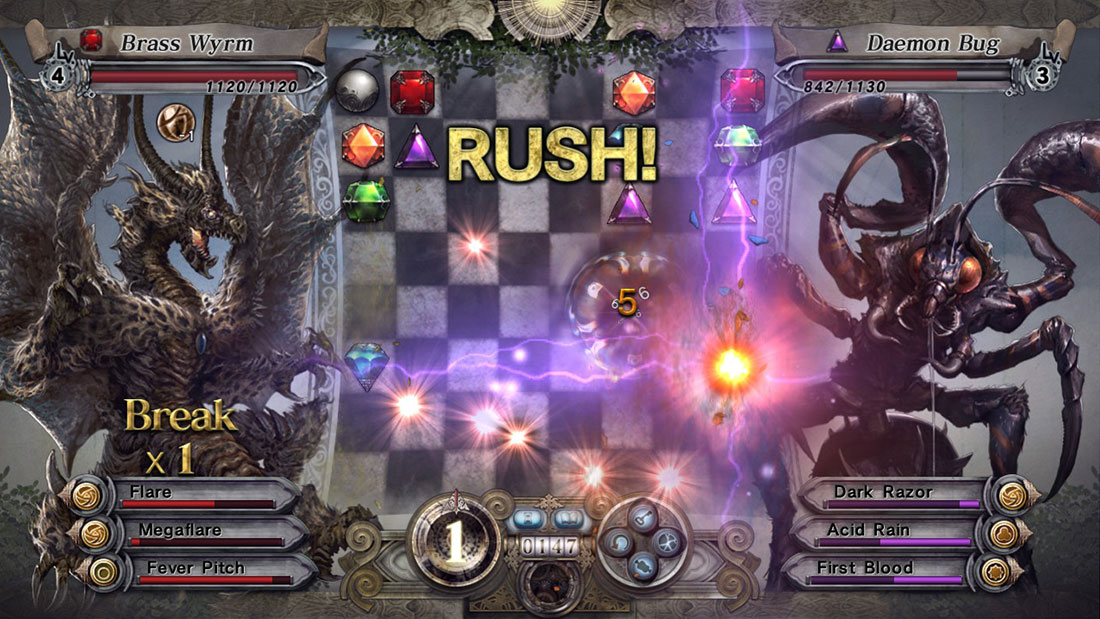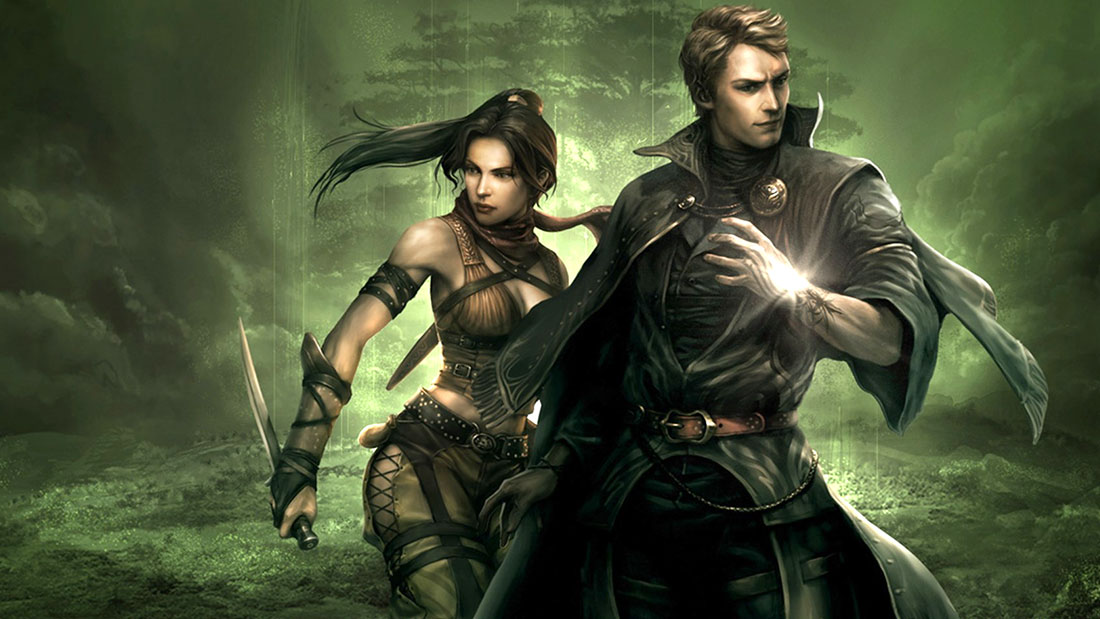Gyromancer | Principal Platforms: PC, Xbox 360 | Developer: PopCap Games | Publisher: Square Enix | Genre: Adventure, Puzzle | Year: 2009
It was said in 2009 and it’s worth saying now: Square Enix and PopCap Games; what an odd couple! Gyromancer was the result of their union; a rather unique game that seemed determined to go in a different direction to where most puzzlers were heading at the time.
Now, it’s important to state the influences that Gyromancer shares before going any further with that statement. Its hybrid genre is clearly inspired by Infinite Interactive’s Puzzle Quest; a perfect example of things coming full circle seeing as Puzzle Quest itself lifted elements from PopCap’s Bejewelled franchise.
Gyromancer also borrows Bejewelled’s gameplay in support of an adventure featuring wizards dueling for supremacy in the depths of an enchanted forest. Like Puzzle Quest, players traverse node-based maps collecting items and gathering experience points, all the while fighting giant monsters by strategically matching gems on a puzzle board.
One Square Enix-y trait here that will quickly become apparent to new players is the gorgeous presentation. It only takes a quick look to appreciate the breadth of quality artwork that Gyromancer has to its name. The bestiary is jam-packed with wondrous creature portraits including giant spiders, rock monsters, and other chimeric beauties. You can tell that a lot of effort went into realizing these graphics because elsewhere the game feels a bit muted.
Each chapter takes place on a map that’s just a collection of white nodes and generic icons set against a boring forest background. The puzzle board is the complete opposite by comparison, with its sharp and colorful appearance bolstered by a wide variety of gem types and impressive particle effects. The music is decent, but it too becomes repetitive because the chapters are usually quite long and the game only has a few different battle themes.
Gyromancer is an easy game to jump into, but the overall experience certainly has a more “hardcore” feel than you’d first expect. You can see more of Square Enix’s hand prints on this: the chapters that wear your character down through attrition; the complex monster skills and penalties for idly twisting gems; some of it is quite harsh.
However, many of these wrinkles do bring welcome complexity to the basic loop of matching gems, and it has to be said that the real-time combat is a huge selling point in its own right. Players are always wandering into battle, but unlike Puzzle Quest, there are no opposing turns to wait for because enemy behavior is automated. Each battle is primarily determined by the decisions you make when matching gems; the combinations you can spot and the risks you’re willing to take in order to set up damaging cascades.
Combat is typically quite fast and engaging because of this, with the general flow depending on the monster you summon into each battle. A monster’s skills and their elemental strengths and weaknesses all have a profound effect on battle, thus encouraging you to carefully assemble your roster of summons before starting the next chapter.
There are moments when Gyromancer can be quite exciting, but the adventuring elements don’t go far enough for me. I’ve always thought that giving players the ability to customize their monsters could have made things more strategically satisfying. Each monster comes with a default set of skills and physical attributes that make some monsters demonstrably better than others.
Why anyone would ever choose to summon the gnat monster, for instance, is beyond me. One of its skills will lock a gem on the board and another slowly saps an opponent’s health, which is a massively risky method of play when you consider that twisting gems and scoring fast combos is part of the game’s structure. Limiting the choices you can make whilst increasing the effect that randomness can have on a battle’s outcome isn’t a recipe for success. Then you have the tree monster who also gets more effective the longer you can drag out a fight. It’s not necessary a weak pick, but attrition and boredom are bound to creep in if players are encouraged to operate that way.

Continue to make successful twists of gems and your combo chain increases. If you can somehow last long enough to raise its level to 6, a special “Gyro Chain” gets triggered that essentially wipes out whatever is left of your opponent. Pulling off this weirdly obscure feat is monumentally difficult. Most players wouldn’t even be aware of its existence were it not for the achievement that accompanies it.
Puzzle Quest also had character levels that meant more. A level-up in that game could bring new spells and attribute points; something to look forward to compared to Gyromancer’s flavourless bars and level caps that lead to little except a feeling of grind.
An overwhelming feeling of repetition creeps in as the chapters start getting longer. Failing one can be really aggravating as it means replaying through many battles to reach your previous position. It’s a situation that’s not exactly helped by the fuzzy definition between the setting and the mechanics. The fact that your avatar is a kaiju-summoner doesn’t seem especially relevant to the cutscenes he takes part in, and there are a quite a few battles where you’re instructing these behemoths to attack other human beings who you’d think would be crushed in a single blow.
The story is also fairly braindead. It’s an uneventful yarn concerning wizards hunting rebels in the woods, occasionally intermixed with mystical tomfoolery and worthless side characters. At one point your female sidekick gets slain, only to be brought back to life and then promptly slain again. Useless!
Gyromancer had a spotty reputation on release due to its bugs. The premium day one expansion pack couldn’t be accessed in-game for months on Xbox 360 before it was finally patched. The PC version on the other hand includes the DLC expansion for free and it also seems to ditch the microtransactions that allowed players to purchase consumable items that dramatically lower the difficulty of encounters.
The consumables in the Xbox 360 version actually became my first exposure to the concept of consumables in mainstream gaming, to the point where I couldn’t initially comprehend the idea of buying an item for a video game and not getting it back after using it! The breadth and price point of these items in Gyromancer is hilariously low by today’s standards, and yet it makes me wonder how you’re supposed to complete those rock-hard DLC challenges without them.
Another thing that the PC version loses, however, are achievements. Steam may not have supported achievements at the time of release, but it remains a surprisingly disappointing omission. The achievements in Gyromancer really pushed the player towards earning the associated list of awards for each chapter. Without achievements marking your progress, the system feels a bit pointless. The game also likes to crash a lot on PC, making this version hard to recommend even with the DLC freebie.


Leave A Comment